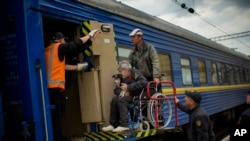They have helped millions flee to safety, brought foreign leaders to Kyiv and transported countless metric tons of goods: for Ukraine, trains have played a crucial role in countering the Russian offensive, its railway chief said.
"Some say the railways have been like a second army," Oleksandr Kamyshin, head of Ukraine Railways, told AFP in an interview.
"When the war started, we had to react quickly so that's exactly what we did."
From the moment Russia attacked on February 24, the railways were essential for getting people to safety, Kamyshin said.
"Since the start of the war, 3.8 million people were evacuated from the east and the south of Ukraine toward the west, and 600,000 people in the west toward neighboring countries," like Poland, Romania and Moldavia, he said.
But the network has also found itself in the sights of Russian bombers. Kamyshin said that in April, Moscow was "systematically" targeting Ukraine's railway infrastructure, suspecting the trains were being used to bring in Western arms.
Although he refused to say whether the railway had played any role in transporting such weapons, Kamyshin said the infrastructure was being constantly repaired so the trains could keep running.
"Dozens of bridges were destroyed, but we are constantly rebuilding," he said, pointing to a bridge in Irpin, a strategic suburb west of Kyiv, which was "rebuilt in 29 days" — a job that would normally have taken months.
But it will take years to rebuild Ukraine's rail network, Europe's third-longest after Germany and France, with 23,000 kilometers (14,300 miles) of track. It is also the country's biggest public employer.
166 staff killed, 252 wounded
Since the war began, Ukraine Railways and its 230,000 employees have been praised both at home and abroad.
In April, British Prime Minister Boris Johnson applauded the resilience of the railway's "iron people" on a visit to Kyiv, and Canadian Prime Minister Justin Trudeau also thanked the rail staff when he visited a month later.
For Kamyshin, an imposing 37-year-old with hair pulled back into a tuft and shaved at the sides, “Viking style,” its success was down to simplifying decision-making and reducing bureaucracy — "something we started changing on the very first day," he said.
Since taking the helm in August 2021, he has pushed through reforms to Ukraine Railways — which before the conflict had been subject to fierce criticism over its Soviet-style system and low quality of service.
Railway employees have paid a high price for their work during the war. Kamyshin said 166 have been killed, 252 wounded and five taken hostage.
Despite Russia's occupation of territory in the south and east of the country, about “90% of the network" remains in Ukrainian hands, he said.
Even when the Russians took over areas in the Kyiv region in March, Ukraine Railways still controlled "up to 75% of the network," he added.
Freight transport collapse
Freight transport, however, has collapsed, and the volume transported has fallen to about 40% of the amount before the war.
Previously, Ukraine exported 50-60 million metric tons of grain per year and “Ukraine Railways transported half, taking it from across the country to its seaports," Kamyshin said.
Last November, some 4.1 million metric tons of grain were transported by rail in a record month. Now that figure is a quarter of what it was, Kamyshin said.
Transportation has been paralyzed since Russia imposed a naval blockade on Ukraine's Black Sea ports, choking off its grain exports.
Since then, Kyiv has had to find alternative routes, notably through Poland and Germany — but the volumes are far lower, and vulnerable to attack.
In April, Russian forces repeatedly struck a bridge on a strategic route linking the southern port of Odesa with Romania.
High-speed Kyiv-Warsaw link
Given the heavy financial losses sustained by Ukraine Railways and the extensive damage to its network, it will need "a lot of money" to recover, Kamyshin said.
"That's why we are waiting for a new Marshall Plan," he said, referring to the vast U.S. economic aid program for Europe's reconstruction put in place after World War II.
One of the long-term projects Kamyshin has in mind is a high-speed rail link between Kyiv and Warsaw, which he said is already undergoing a feasibility study.
Ukraine Railways has also been playing a major role along the new "Silk Road" route for cargo transport between China and Europe, although this has been completely halted by the war.
Before the conflict, "container transport was constantly increasing," Kamyshin said.
"We would be happy if we could find a way to bring Chinese goods back to Europe, but without Russia this time," he added.





